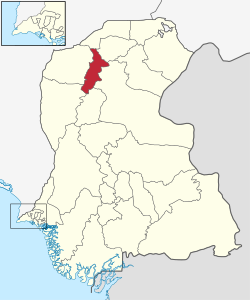Larkana (District)
| Larkana district | |
| State : |
|
| Province : | Are |
| Seat : | Larkana |
| Coordinates : | 27 ° 34 ' N , 68 ° 14' E |
| Area : | 1 906 km² |
| Residents : | 1,524,391 (2017) |
| Population density : | 800 inhabitants per km² |
| Time zone : | PST ( UTC + 5 ) |
| Website : | |

|
|


Larkana District is an administrative district in Pakistan in Sindh Province . The seat of the district administration is the city of the same name Larkana .
The district has an area of 1906 km² and according to the 2017 census 1,524,391 inhabitants. The population density is 800 inhabitants / km². The Sindhi language is spoken by the majority in the district .
The ruins of the ancient city of Mohenjodaro are in the district.
geography
The Sukkur district is located in the northern part of Sindh and is traversed by the Indus in the east .
Administrative division
The district is administratively divided into five tehsil :
Demographics
Between 1998 and 2017, the population grew by 2.23% annually. About 46% of the population live in urban areas and about 54% in rural areas. 778,249 men, 746,093 women and 49 transgender people live in 261,331 households , resulting in a gender ratio of 104.3 men per 100 women, which is a common surplus for Pakistan.
| year | population |
|---|---|
| 1972 | 460.735 |
| 1981 | 572.006 |
| 1998 | 1,001,608 |
| 2017 | 1,524,391 |
education
The literacy rate in the years 2014/15 among the population over 10 years of age was 58% (women: 45%, men: 72%) and thus slightly below the average for the Sindh province of 60%.
Others
The Bhutto family, who play an important role in national and local politics, comes from the Larkana district. Members of this family include the former Prime Ministers of Pakistan Zulfikar Ali Bhutto (1973–1977) and Benazir Bhutto (1988–1990 and 1993–1996).
Web links
Individual evidence
- ↑ a b DISTRICT WISE CENSUS RESULTS CENSUS 2017. August 29, 2017, accessed May 30, 2019 .
- ↑ Pakistani Districts wise Population Census 2017. Accessed May 30, 2019 .
- ^ Pakistan Bureau of Statistics (2016). Pakistan Social and Living Standards Measurement Survey 2014-15. Government of Pakistan, accessed June 29, 2019 .